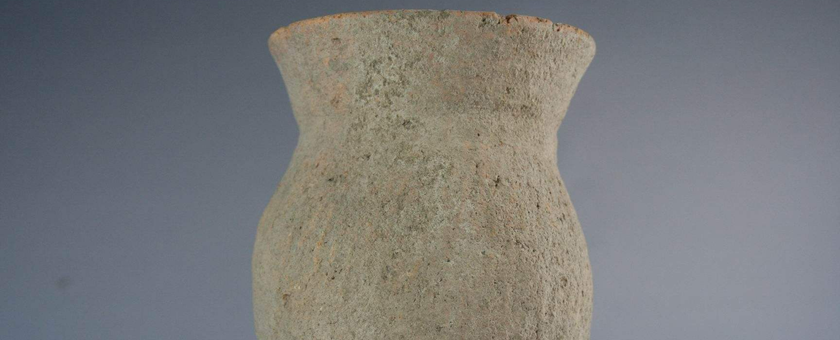Pottery
Pottery is a utensil made of clay that has been shaped and fired. Pottery has a long history. In the Neolithic Age, there has been some simple rough potteries.

History of Chinese Pottery
In the early Neolithic Period, pots could only be made by hand. The clay is rolled into a rope and carefully smoothed with the oars outside, pressing against the anvil inside the wall. Later, in the primitive Yangshao Period, the pottery wheel was invented. The kiln was also improved, and the production of pottery had a leap forward. During the Longshan culture at the end of the Neolithic Age, fast wheels were used and pottery reached record heights, represented by white pottery and black pottery as thin as an eggshell. White pottery was mainly used by aristocratic slaveholders, so it was covered with various patterns, such as animal faces, clouds and waves. Black pottery, as the name suggests, is made black, which is actually the last part of its production. People know the shape of the black pottery, but not the pattern on its surface.
During the Zhou Dynasty (11th century-771 BC), pottery was given various designs and decorations. It wasn't until the Qin Dynasty (221 bc-207 BC) that the pottery industry entered a new era. Archaeologists have been amazed by the superb technique of the world-famous Qin Terra-cotta Warriors and Horses unearthed in Xi 'an, Shaanxi Province. Innovations and experiments were carried out in the later dynasties until the Tang Dynasty (618-907), thus making another great leap forward. Tri-colored pottery of the Tang Dynasty appeared and won world fame. Since Tang Dynasty, people have valued lavish funerals, and fine pottery has been used as burial objects, including statues of officials, dancers, warriors and animals.
By Song Dynasty, pottery was gradually replaced by porcelain. By the Ming Dynasty (1368-1644), dark-red enameled pottery began to appear. As there was no dark-red enameled pottery anywhere else, dark-red enameled pottery is produced especially in Yixing, Jiangsu Province. Dark-red enameled pottery is a favorite of many Chinese, especially tea drinkers.

Famous Pottery in China
Yixing Purple Clay Pottery
Yixing Purple Clay Pottery is the most famous purple sands pottery in China. The texture of purple sand is hard, fine, dark and exquisite. Different mixing techniques and cooking temperatures produce a variety of colors, such as sky blue, chestnut, dark red, pear yellow, vermilion, begonia, light gray, dark green, and so on.
This is the most iconic pottery in China, with a variety of shapes and delicate combinations of lines and planes. There are two main designs, which involve imitating certain natural objects, such as fruit or flowers. The main products are tea sets, flower POTS, etc., among which tea sets are the most famous. It's great to keep the flavor of the tea when it's being made and the color of the tea when it's being stored. If you sit in a purple clay tea set on a hot day, the tea won't go bad, and the material can keep you warm without burning your hands. Among them, Purple Clay Pottery set is known as the king of the world.
Yixing Purple Clay Pottery first appeared in Song Dynasty and developed rapidly in Ming and Qing Dynasties. Especially in Ming Dynasty Zhengde, Jiajing years, purple sand art became more prevalent. At this time, the purple sand artisans made their existence known for the first time. Since then, the industry has produced a host of gurus. Yixing purple clay pottery won the gold medal at the Chicago International Exposition in 1926 and the silver medal at the Belgian Exposition in 1930. After the founding of new China, Yixing purple sand handicrafts have a new development, new color (blue), new technology (gold foil Mosaic), traditional technology (sculpture, relief, printing, decal, etc.) and other new technologies.

Tang Tri-colored Pottery
Another good example of fine pottery is the Tang Tri-colored Glazed Pottery (618-907). The fragments are made by adding various metal oxides and baking them at low temperatures. Glazed pottery may appear light yellow, reddish brown, clover, or light green. The most popular colors are yellow, brown and green. The sculptures of people, animals and everyday objects are strikingly consistent with the elegance and liveliness of Tang art. The three colors of glaze favored by many foreigners have been shipped all over the world.

How to Maintenance of Pottery
Ancient Chinese ceramics are the bright pearl in the treasure house of human culture and art because of various factors most of the ceramics have different degrees of damage.
(1) The ideal way to store pottery is to put it in a custom-made box with a sponge or foam mat. Do not put two pieces of pottery together. If they must be put together, separate them with foam. (2) Keep your hands clean and dry while playing with the pottery. Take off the ring as it will scratch the glaze.
(3) When taking and placing pottery figure sculptures, attention should be paid to the hair and fingers of the sculpture, because this part is the most slender prominent, easy to damage.
(4) Usually we can use a wet cloth to wipe the pottery and a soft brush to brush the chinaware.


 Flow us
Flow us

